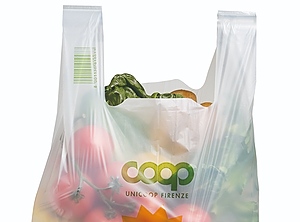BIOPLASTICS
New EU standard for home compostable carrier bags
 Compostable? (Photo: Unicoop / European Bioplastics) |
With EN 17427 (DIN EN 17427:2022, Packaging – Requirements and test methods for home compostable carrier bags), a new standard was published this year that defines the requirements and specifications for home compostable carrier bags. According to industry association European Bioplastics (EUBP, Berlin; www.european-bioplastics.org), the regulation includes requirements for home composting and specifications for ecotoxicity testing and safety testing.
The biggest difference between home composting and industrial composting is the temperature – industrial composting plants reach 50 °C to 70 °C, while home composting takes place at ambient temperatures. Various studies have shown that plastic composting at home does not work efficiently. Most recently, researchers from UK Plastic Waste Innovation Hub at University College London (UCL, London; www.ucl.ac.uk) investigated UK consumers’ handling of plastics labelled as compostable and/or biodegradable (see Plasteurope.com of 11.11.2022).
Related: Scientists find compostable plastics with strength of spider silk
When the EU Packaging and Packaging Waste Directive (PPWD) was amended in 2015, the EU’s main focus was on reducing plastic bags. In some countries, compostable bags made of PLA or starch mixtures were exempt from the ban. In Germany, a ban on plastic bags has been in force since this year (see Plasteurope.com of 23.12.2020).
However, according to the European industry association, the most important standard for the composting of plastic products remains EN 13432 (DIN EN 13432:2000-12, Packaging – Requirements for the recovery of packaging by composting and biodegradation), which is currently being revised.
Related: EU draft PPWD sets targets for reuse, recycling
The biggest difference between home composting and industrial composting is the temperature – industrial composting plants reach 50 °C to 70 °C, while home composting takes place at ambient temperatures. Various studies have shown that plastic composting at home does not work efficiently. Most recently, researchers from UK Plastic Waste Innovation Hub at University College London (UCL, London; www.ucl.ac.uk) investigated UK consumers’ handling of plastics labelled as compostable and/or biodegradable (see Plasteurope.com of 11.11.2022).
Related: Scientists find compostable plastics with strength of spider silk
When the EU Packaging and Packaging Waste Directive (PPWD) was amended in 2015, the EU’s main focus was on reducing plastic bags. In some countries, compostable bags made of PLA or starch mixtures were exempt from the ban. In Germany, a ban on plastic bags has been in force since this year (see Plasteurope.com of 23.12.2020).
However, according to the European industry association, the most important standard for the composting of plastic products remains EN 13432 (DIN EN 13432:2000-12, Packaging – Requirements for the recovery of packaging by composting and biodegradation), which is currently being revised.
Related: EU draft PPWD sets targets for reuse, recycling
20.12.2022 Plasteurope.com [251740-0]
Published on 20.12.2022

 German version of this article...
German version of this article...